The differentiation of response numerosities in the pigeon
- PMID: 17970413
- PMCID: PMC1986432
- DOI: 10.1901/jeab.2007.41-06
The differentiation of response numerosities in the pigeon
Abstract
Two experiments examined how pigeons differentiate response patterns along the dimension of number. In Experiment 1, 5 pigeons received food after pecking the left key at least N times and then switching to the right key (Mechner's Fixed Consecutive Number schedule). Parameter N varied across conditions from 4 to 32. Results showed that run length on the left key followed a normal distribution whose mean and standard deviation increased linearly with N; the coefficient of variation approached a constant value (the scalar property). In Experiment 2, 4 pigeons received food with probability p for pecking the left key exactly four times and then switching. If that did not happen, the pigeons still could receive food by returning to the left key and pecking it for a total of at least 16 times and then switching. Parameter p varied across conditions from 1.0 to .25. Results showed that when p= 1.0 or p=.5, pigeons learned two response numerosities within the same condition. When p=.25, each pigeon adapted to the schedule differently. Two of them emitted first runs well described by a mixture of two normal distributions, one with mean close to 4 and the other with mean close to 16 pecks. A mathematical model for the differentiation of response numerosity in Fixed Consecutive Number schedules is proposed.
Figures
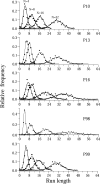

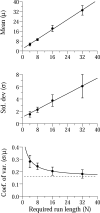

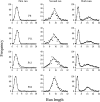
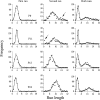
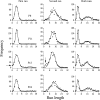





References
-
- Alsop B, Honig W.K. Sequential stimuli and relative numerosity discriminations in pigeons. Journal of Experimental Psychology: Animal Behavior Processes. 1991;17:386–395.
-
- Emmerton J. Birds' judgments of number and quantity. In: Cook R.G, editor. Avian visual cognition. 2001.
-
- Fetterman J.G. Numerosity discrimination: Both time and number matter. Journal of Experimental Psychology: Animal Behavior Processes. 1993;19:149–164. - PubMed
-
- Fetterman J.G, Dreyfus L.R, Stubbs D.A. Scaling of response-based events. Journal of Experimental Psychology: Animal Behavior Processes. 1985;11:388–404.
Publication types
MeSH terms
LinkOut - more resources
Full Text Sources

